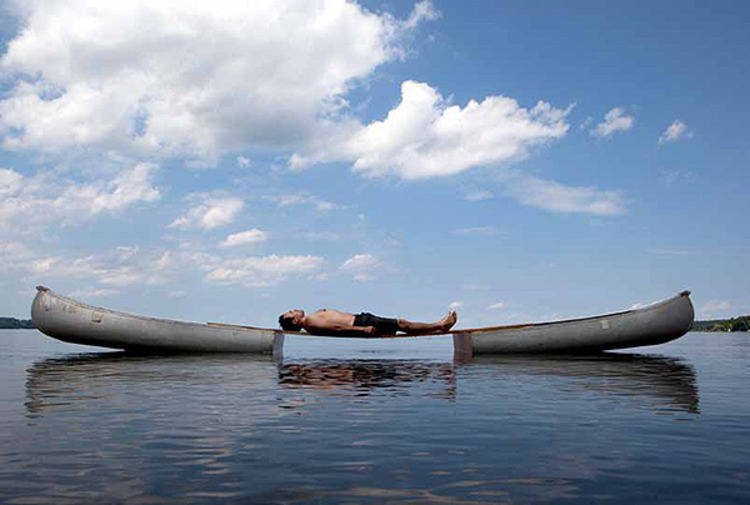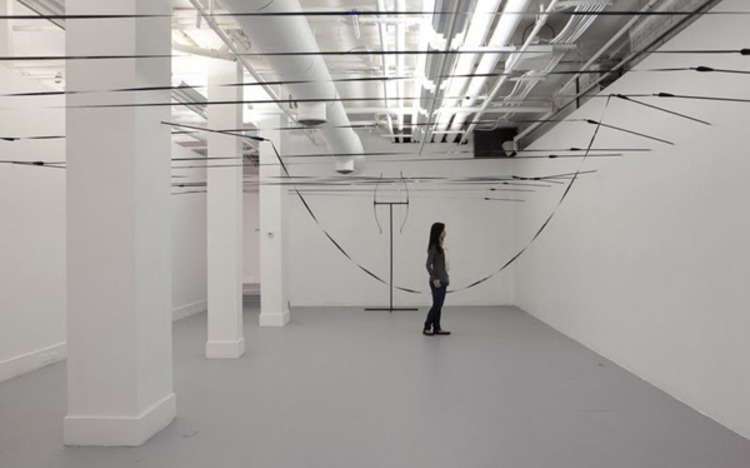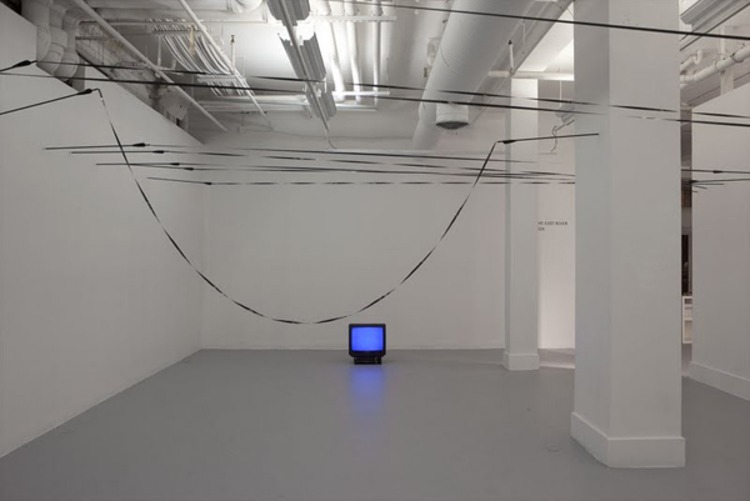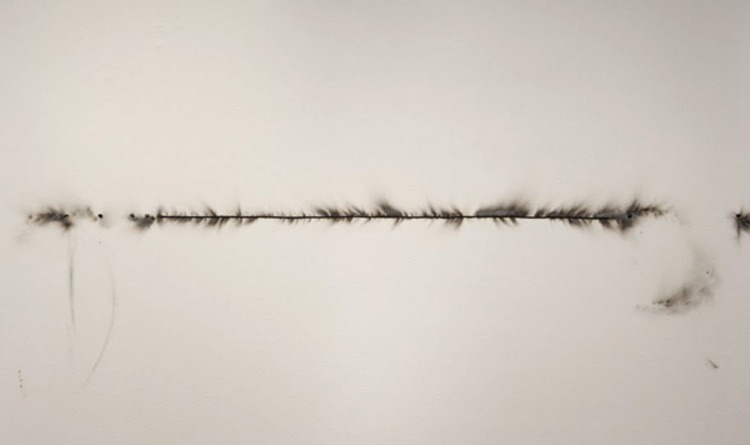November 10 – December 19, 2009
Artspace, New Haven, CT
Time is Like the East River marks a first for Artspace. It marks the first time we have given the entire gallery space over to one artist; it is also the largest exhibition to date of William Lamson’s work. Innovative and ambitious are only two of the many apt descriptors for Lamson. In this exhibition alone, the artist produced three site-specific installations—including a fantastic public artwork— that convey a sense of urgency, risk, imagination, and a deep passion for pushing physical and conceptual boundaries of place, space, and time.
Lamson is an exploratory artist who has an uncanny facility for creating profound works from small gestures. In Time is Like the East River, he uses the time-based mediums of video, photography, and performance to question the nature of time as a material, form of measurement and symbol of transformation. His ethereal drawings, created through uncontrollable forces, are paradoxical objects: they ask us to consider our own mortality while denying the presence of a human hand.
There are moments in Lamson’s work where his probing of time appears as a singular, personal quest; yet this impression is just window-dressing for an artist wrestling with larger ideas about individual and communal space. Using time as his subject, his exhibition reveals conversations with and about time as a communal experience—one that is both relevant and obsolete.
Employing “modernized artifacts,” like the medieval-style cart, Lamson’s work informs this conversation and brings together a community of viewers. In each installation—the lyrical wall drawing made with firecrackers and fuses, or the perfectly polished half canoe, the clock that keeps a different time or an over-sized basketball court—he shows us a place where art and the community are “reconciled at a place of intersection.”
View exhibition catalogue: East_River_LowRes
Featured Image:
Untitled, 2009
Digital chromogenic print
40 x 27 inches
Courtesy of the artist
In PLAY/PAUSE, Lamson uses videotape and arrows to create a line drawing in space. A series of approximately seven-foot tall by eighteen-foot wide lines span the space between a seemingly abstract modernist sculpture, located at one end of the gallery, and a glowing blue television monitor at the other. Developed from his ongoing interest in simultaneity, chance, and elemental physics, Lamson fabricated a seven-foot tall black metal armature rigged with two bows. When pulled taut the bows release two arrows in opposing directions. Lamson moved from one end of the gallery to the other, setting up the armature in the same position each time, yet each set of lines is slightly different from the next. In some, the tape is somewhat twisted and slack, in others, the tape remains straight and taut. The directional angles of the bows are similarly varied. Such subtle distinctions speak to the unforeseen forces that lie beyond the artist’s physical control, providing variations on predictable outcomes. Lamson employs time as a malleable medium; the videotape, a conventional recorder of time, is literally stretched between two physical points. The consistent blue hue emanating from television is the result of time being arrested in a state of infinite pause.
PLAY/PAUSE installation
In conjunction with PLAY/PAUSE, the line drawing in space on the interior of Gallery 1, Lamson uses the exterior wall of the gallery to create a drawing from equally unlikely materials. Evoking a theoretical timeline, the drawing is made from fuses and firecrackers, materials that both signify singular moments and lengths of time. Lamson subverts the traditional timeline progression, creating the drawing by lighting the fuse from both ends.
Timeline installation
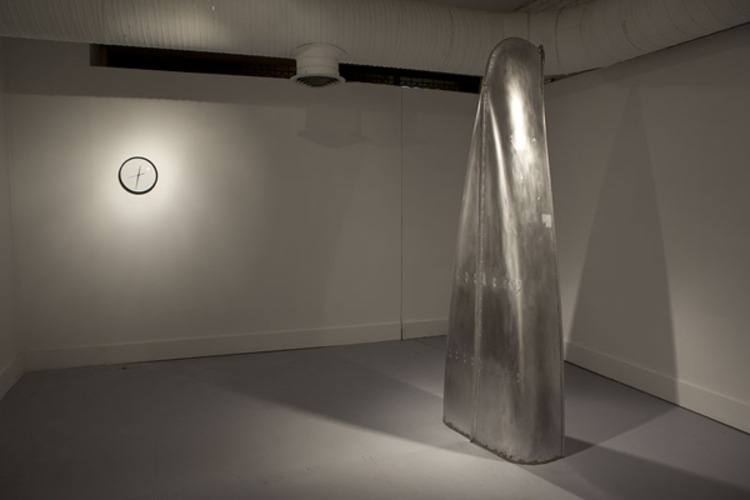
Installation view: Time is like The East River, 2009
Clock, half canoe
Courtesy of the artist
At first glance, the gleaming metal object in the gallery conjures a pristine minimalist sculpture. The highly polished form subtly speaks to Brancusi’s iconic Bird in Flight and the minimalist ethos of sculptor Donald Judd. Yet, the polished metal is simply one half of Lamson’s fragmented canoe. Up-ended and stripped of its utility, Lamson’s canoe becomes a contemplative object, a luminous sculpture. Notions of utility are similarly elided with the presence of the wall clock. This timepiece measures slack tide—specifically the speed of the tide—and it is set to the day and time of Lamson’s performance on the East River. At slack tide, daily time is essentially arrested, creating a brief window of time in which the normally turbulent waters are calm. This period is signaled by a series of bells that sound at the beginning and end of slack tide. The second hand on the clock runs according to the speed and direction of the current, upon the completion of the tidal change, the second hand moves in the opposite direction.
Long Shot
Opening day, Sept 13, 2009
Intervening in familiar space is integral to Lamson’s vigorous artistic practice. And, Long Shot (2009) is emblematic of the artist’s interest in how transformations of space—often altered through deceptively simple means—affect us. The medieval-looking wooden cart filled with bright inflatable balls, the digital photograph and short video, are the props, artifacts, and documents from the site-specific installation.
Long Shot occurred as a performance and installation. The opening reception for the work was the performance. Two teams played a pick-up basketball game to five points: the game took over twenty minutes to complete. The physical installation consists of two over-sized basketball backboards and rims that have been affixed to two 25’ rigger poles located on the grounds of The Lot—a small pocket park and transit stop located three blocks from Artspace at the corner of Chapel and Orange Streets. Made from weathered two-by-fours, found and soldered rebar, and rope, Lamson’s homespun backboards are 2.5 times the size of a regulation size board. At The Lot, Lamson installed each of the backboards onto opposing two of the opposing rigger poles, creating a makeshift basketball court in the process. Donated basketballs were available at the gallery for anyone to use. The act of playing basketball became exceedingly hard, the shorter court and increased elevation of the hoop required double the effort to score. By exaggerating the scale of the hoops, Lamson alters the physics of the game, in turn, bringing new awareness to our own physical limitations.
